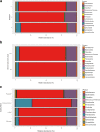Rare gut microbiota associated with breeding success, hormone metabolites and ovarian cycle phase in the critically endangered eastern black rhino
- PMID: 30770764
- PMCID: PMC6377766
- DOI: 10.1186/s40168-019-0639-0
Rare gut microbiota associated with breeding success, hormone metabolites and ovarian cycle phase in the critically endangered eastern black rhino
Abstract
Background: Host microbiomes play a role in hormone production and subsequent fertility in humans, but this is less well understood in non-model organisms. This is of particular relevance to species in zoo-based conservation breeding programmes, as relationships between host microbiome composition and reproductive output may allow for the development of microbial augmentation strategies to improve success. Here, we characterise faecal bacterial communities of breeding and non-breeding eastern black rhino (Diceros bicornis michaeli) using 16S rRNA gene amplicon sequencing and quantify progestagen and glucocorticoid metabolite concentrations through enzyme immunoassays to identify such relationships.
Results: We identified significant differences in black rhino gut microbiome composition according to ID, institution, breeding success and ovarian cycle phase. In particular, the gut microbiome during pregnancy and post-parturition was significantly altered. Around a third of bacterial genera showed more than ± 10% correlation with either progestagen and/or glucocorticoid concentration, and in general, microbial genera correlated with both hormones in the same direction. Through a combination of analyses, we identified four genera (Aerococcaceae, Atopostipes, Carnobacteriaceae and Solobacterium) that were significantly associated with breeding success, pregnancy and/or post-parturition, and higher faecal progestagen metabolite concentrations. These genera had a lower-than-average relative abundance in the gut microbiome.
Conclusion: Our results indicate that many members of the gut microbiome of black rhino are associated with hormone production and breeding success, and some members of the rare microbiota appear to be particularly important. Although the directionality of the relationship is unclear, the variation in gut microbiome communities represents a potential biomarker of reproductive health. We identified four genera that were associated with multiple indicators of reproductive output; these could be candidate probiotics to improve the breeding success of black rhino in zoo-based conservation breeding programmes. Further work is required to understand the efficacy and feasibility of this, either directly through microbial augmentation (e.g. probiotics) or indirectly via dietary manipulation or prebiotics.
Keywords: Conservation breeding programmes; Faecal metabolites; Glucocorticoids; Indicator analysis; Progestagens.
Conflict of interest statement
Ethics approval and consent to participate
This study was approved by the University of Salford Research, Innovation and Academic Engagement Ethical Approval Panel (reference number ST1617-83) in addition to ethical approval for the use of samples by Port Lympne Reserve, Chester Zoo and the University of Manchester.
Consent for publication
Not applicable.
Competing interests
The authors declare that they have no competing interests.
Publisher’s Note
Springer Nature remains neutral with regard to jurisdictional claims in published maps and institutional affiliations.
Figures




References
-
- Fitzpatrick CR, Copeland J, Wang PW, Guttman DS, Kotanen PM, Johnson MTJ. Assembly and ecological function of the root microbiome across angiosperm plant species. Proc Natl Acad Sci. 2018;115:E1157–E1165. Available from: http://www.pnas.org/lookup/doi/10.1073/pnas.1717617115. - DOI - PMC - PubMed
-
- Mckenney EA, Koelle K, Dunn RR, Yoder AD. The ecosystem services of animal microbiomes. Mol Ecol. 2018:0–1. - PubMed
-
- Evans JM, Morris LS, Marchesi JR. The gut microbiome: the role of a virtual organ in the endocrinology of the host. J Endocrinol. 2013;218:R37–R47. - PubMed
Publication types
MeSH terms
Substances
LinkOut - more resources
Full Text Sources
Other Literature Sources

